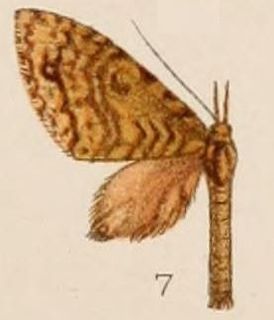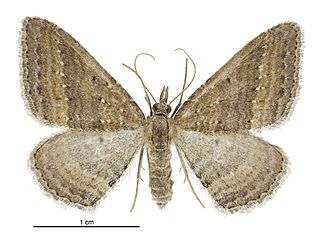
Alexander Walker Scott was an Australian entomologist mainly interested in butterflies.

Larentiinae is a subfamily of moths containing roughly 5,800 species that occur mostly in the temperate regions of the world. They are generally considered a subfamily of the geometer moth family (Geometridae) and are divided into a few large or good-sized tribes, and numerous very small or even monotypic ones which might not always be valid. Well-known members are the "pug moths" of the Eupitheciini and the "carpets", mainly of the Cidariini and Xanthorhoini. The subfamily was described by Philogène Auguste Joseph Duponchel in 1845.

Epyaxa rosearia, the New Zealand looper or plantain moth, is a moth of the family Geometridae.It is endemic to New Zealand.

Sandava scitisignata, the fungi snout, is a moth of the family Erebidae first described by Francis Walker in 1862. It is found in the southern half of Australia.

Scopula rubraria is a species of moth of the family Geometridae. It is native to both New Zealand and Australia.

Epyaxa subidaria, the subidaria moth, is a moth of the family Geometridae. The species was first described by Achille Guenée in 1857 and it is native to Australia, including Tasmania.

Syneora mundifera, the forest bark moth, is a moth of the family Geometridae first described by Francis Walker in 1860. It is found in Australia.

Carmara is a monotypic moth genus of the family Noctuidae. Its only species, Carmara subcervina, is found in Sri Lanka, Japan, Taiwan, Borneo and Australia. Both the genus and species were first described by Francis Walker in 1864.

Epyaxa is a genus of moths in the family Geometridae erected by Edward Meyrick in 1883.

Phrissogonus is a monotypic moth genus in the family Geometridae erected by Arthur Gardiner Butler in 1882. Its only species, Phrissogonus laticostata, the apple looper, was first described by Francis Walker in 1862. It is found in Australia, New Caledonia and New Zealand.

Sauris is a genus of moths in the family Geometridae erected by Achille Guenée in 1857.
Rivula curvifera is a moth of the family Erebidae first described by Francis Walker in 1862. It is found in Australia, China, Japan, Taiwan and on the Korean Peninsula.

Euteliidae is a family of moths in the superfamily Noctuoidea. The family was erected by Augustus Radcliffe Grote in 1882.

Pinara metaphaea, the pinara moth, is a species of moth of the family Lasiocampidae. It was first described by Francis Walker in 1862. It is known from south-east Australia, including New South Wales and Victoria.

Negeta contrariata is a moth in the family Nolidae first described by Francis Walker in 1862. It is found from the Indo-Australian tropics of India, Sri Lanka, Borneo east to Australia (Queensland) and the Bismarck Archipelago.
Eriopithex recensitaria is a moth in the family Geometridae first described by Francis Walker in 1862. It is found in Sri Lanka, Taiwan, on Borneo and in the Australian state of Queensland.

Collix ghosha is a moth in the family Geometridae. It was described by Francis Walker in 1862. It is found in the Indo-Australian tropics, from the Indian subregion, Sri Lanka to Queensland, Japan and New Caledonia.
Teulisna chiloides is a moth in the family Erebidae. It was described by Francis Walker in 1862. It is found on Peninsular Malaysia, Sumatra, Borneo, Sulawesi and Sumbawa. It has also been recorded from Queensland, Australia. The habitat consists of lowland dipterocarp forests, alluvial forests and lower montane forests.

Epyaxa venipunctata is a species of moth in the family Geometridae. It is endemic to New Zealand. This species was first described by Francis Walker in 1863.
















